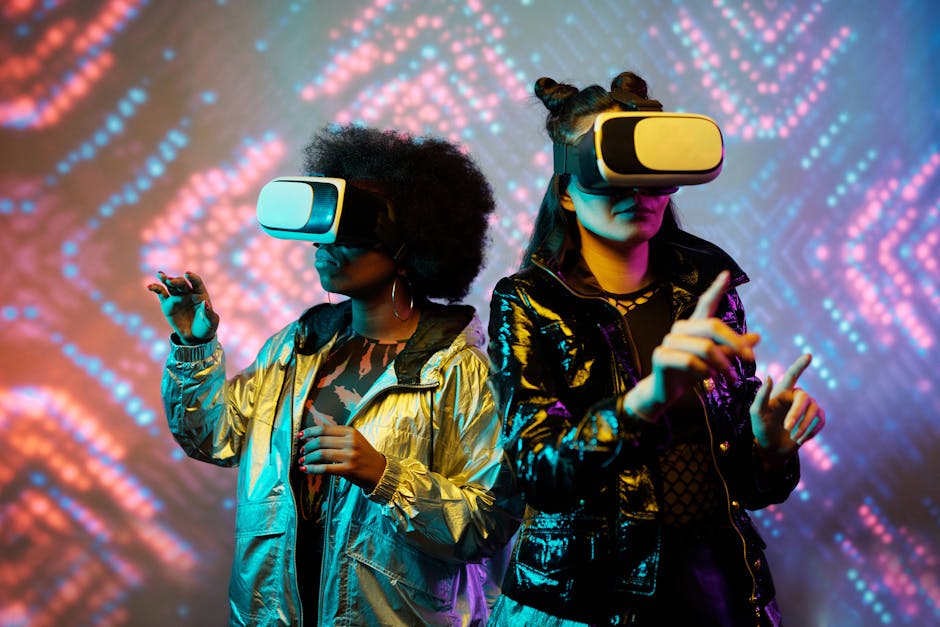The Intersection of Art and Technology
Virtual Reality (VR) is reshaping political art, offering new ways to engage with complex issues. It transports us into digital recreations of significant places, allowing artists to create immersive experiences that challenge perspectives.
Nancy Baker Cahill's 4th Wall project uses augmented reality to overlay art onto real-world locations, prompting viewers to consider alternative viewpoints. VR documentaries plunge viewers into environments they might never otherwise experience, from climate-impacted lands to war-torn communities.
Artists like Cao Fei use VR to explore themes of modernization and progress, while others harness the technology to amplify underrepresented voices. As a tool, VR offers new canvases for activism, making the impossible plausible and activism tangible.
While some worry about VR's potential to distract from real-world issues, its true power lies in how artists use it to spark conversations and inspire change.
VR as a Tool for Political Activism
VR is emerging as a powerful platform for political discourse and activism. It offers a visceral way to confront uncomfortable truths and explore new perspectives.
Projects like StoryTrails blend archival footage with personal testimonies, creating immersive historical experiences. This approach democratizes storytelling, giving voice to overlooked narratives and connecting past events to current issues.
VR documentaries bring urgent matters into focus, stimulating empathy and encouraging action. By placing viewers directly in others' experiences, these projects transform abstract issues into personal accounts.
While some critics argue that VR might trivialize serious topics, thoughtful use of the technology can elevate awareness and promote meaningful dialogue. As VR continues to evolve, it has the potential to redefine activism for the digital age, building bridges and sparking debates in ways traditional media cannot.

Challenges and Criticisms of VR in Political Art
Despite its potential, VR in political art faces criticism. Some worry about the risk of escapism, fearing that immersive digital experiences might distract from real-world issues. There's also concern about the potential for manipulation, as VR's powerful ability to evoke emotions could be used to sway opinions.
The ethical implications of recreating traumatic experiences in VR raise questions about the balance between fostering empathy and potentially re-traumatizing viewers. Critics also worry about desensitization, wondering if repeated exposure to intense virtual experiences might dull emotional responses to real-world issues.
However, thoughtful curation of VR experiences could foster greater empathy and understanding. The key lies in finding a balance between emotional engagement and critical thinking, using VR as a tool to spark dialogue rather than dictate perspectives.
As VR technology advances, artists and activists must navigate these challenges, harnessing its potential while remaining mindful of its impact.
Case Studies of Political Art in VR
Several VR projects showcase the medium's potential for political art:
- "Child of Empire" immerses viewers in the 1947 Partition of India and Pakistan through the eyes of a seven-year-old boy, transforming historical events into an emotional journey.
- Lucy Hammond's "Monoliths" uses VR to create a unique experience where viewers float alongside spoken-word poems by northern women, challenging notions of presence and identity.
- David Olusoga's "StoryTrails" overlays archival footage with contemporary accounts, allowing users to explore hidden histories within urban landscapes.
- Nancy Baker Cahill's 4th Wall project uses augmented reality to place digital sculptures in significant locations, prompting reflection on issues like liberty and immigration.
These projects demonstrate VR's ability to tell compelling stories, amplify marginalized voices, and create new forms of engagement with political and social issues. They challenge viewers to move beyond passive reflection and consider how they might act on the empathy and awareness these experiences evoke.
The Future of Political Art in VR
The future of political art in VR holds exciting possibilities. Advancements in haptic feedback could create more immersive experiences, allowing users to "feel" historical events or protests. AI integration might enable real-time, personalized narratives that adapt to user interactions.
As VR becomes more accessible, we may see a diversification of voices contributing to political art. This could lead to a more inclusive digital space where marginalized perspectives are amplified.
Virtual activism might evolve, with demonstrations and symposiums occurring in immersive environments, potentially fostering transnational collaboration unbounded by geography.
However, as VR technology progresses, so too must the ethical conversations surrounding its use. Maintaining awareness of the line between empathy and manipulation will be crucial.
The future of VR in political art invites us to reconsider not just how activism is portrayed, but how it's enacted. It offers a unique opportunity to engage with global issues more intuitively and instantaneously, potentially fostering a more equitable and conscientious world.
As we look ahead, the potential of virtual reality in political art offers a fresh perspective on engagement and activism. By blending technology with storytelling, VR invites us to rethink how we connect with pressing issues, urging us to become active participants in shaping a more conscientious world.
- Slater M, Wilbur S. A framework for immersive virtual environments (FIVE): Speculations on the role of presence in virtual environments. Presence: Teleoperators & Virtual Environments. 1997;6(6):603-616.
- Hill CA. The psychology of rhetorical images. In: Hill CA, Helmers M, eds. Defining Visual Rhetorics. Mahwah, NJ: Lawrence Erlbaum Associates; 2004:25-40.
- McLuhan M. Understanding Media: The Extensions of Man. New York, NY: McGraw-Hill; 1964.




















